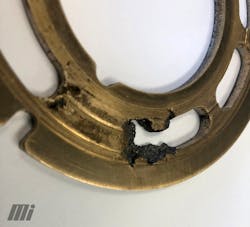Common Modes of Failure for Hydraulic Piston Pumps
Content has been updated as of Oct. 13, 2021.
As the industrial world continues to evolve and add ever-more sophisticated means of reducing unscheduled downtime, discipline is required to ensure that the fundamentals of troubleshooting and failure analysis/analytics aren’t lost. Adding devices to monitor operating conditions does little if you can’t put that feedback into context.
The importance of the information gleaned from the repair and refurbishment of equipment can’t be understated. This should be a critical component of any downtime reduction strategy, as it can deliver more than just the face-value savings that result from repair versus replace. Properly analyzing the mode of failure can provide valuable information about what caused that failure, and thus can be used in an effort to resolve underlying issues. Resolving these underlying issues is the true key to avoiding future unscheduled downtime.
This article will discuss the most common modes of failure for variable displacement piston pumps. Understanding these modes of failure, the causes, warning signs and the prophylactic means of monitoring will help you to reduce unscheduled downtime.
The four most common modes of failure in piston pumps result from oil contamination, fatigue that results from transient pressure spikes, blocked or restricted pump inlet, and pump case over pressurization. These four modes account for the vast majority of all failures seen in the thousands of units inspected and repaired each year by the service technicians working at Motion Industries.
Contamination can be the result of many things, including egress of water, environmental contaminants or component ware elements. Telltale signs of contamination include valve plate scoring, vertical scratches on piston barrels, scratches on the face of pistons, excessive wear of saddle bearings (or embedded particulate), plugged orifices, stuck compensator spools and pistons being seized within the cylinder bore of the barrel.
Ways to monitor for oil contamination within a system include, regular oil sampling/analysis as well as through the utilization of sensors to monitor for things like water saturation and particle count. Utilizing live monitoring in conjunction with periodic oil sampling/analysis is the best way to gain a full understanding of your pump and overall system health.
The fatigue that results from transient pressure spikes will present in the form of broken pistons (at the neck), shafts (where the cylinder barrel rides or at the tail), sheered control pins, damaged yokesthe appearance of cracks between the kidneys of the cylinder barrel. Of the four common modes of failure, this is by far the most difficult problem to identify through electronic monitoring. It takes a device with an exceptionally quick scan rate as spikes can form and dissipate within the window of a few milliseconds.
If you suspect that your system is experiencing transient pressure spikes, hand-held monitoring devices are offered by many OEMs and are an excellent addition to any reliability team’s troubleshooting toolbox.
Blocked or restricted pump inlets will typically present in the form of cavitation on the valve plate or what some service technicians refer to as a “marble sound.” Vacuum at the inlet leads to the formation and collapse of small vapor-filled voids. The shockwave generated by the collapse of these voids leads to the surface damage on the valve plate as well as the telltale sound.
Ways to monitor for this condition include a limit switch mounted on a suction ball valve feeding the pump (a common system interlock), a pressure transducer installed into the suction line or vibration monitoring through the use of accelerometers mounted to the pump.
Pump case over-pressurization can present in the half-moon gouging or full-moon scoring of the swash plate, damaged shoe retainer, bent seal retainer or protruding shaft seals as well as shoe damage—rounded edges, loose fit on the ball and excessive wear on the backs of the shoes. This kind of damage will be the result of shoe lift or rolling caused by the increased case pressure. This condition can be monitored through the use of a pressure transducer in the case line. In practice, however, this is rarely done.
The most common type of monitoring for case drains is flow observation. Monitoring for flow can give you a good indication of pump life—allowing you to see how efficient the pump is running (that is, if 10% is leaving the case only 90% is going into the system). As a guide: Flow greater than 10% of total flow capacity of the pump indicates excessive wear. It is also worth noting that this method of monitoring pump life is not valid for pumps that have an internal check between the case and suction.
Understanding these modes of failure, the signs, root cause and methods for identification will help to reduce unscheduled downtime and improve overall system reliability when it matters most.
Based out of Calgary, Ian Miller, P. Eng. is national services business development manager of Motion Industries Canada. He has more than a decade of hydraulic and electrical experience in the field including system design, troubleshooting, on-site installations and technical training/support.
For more information, please visit MotionIndustries.com/hydraulicsandpneumatics or see MI's Hydraulics Catalog with a wide range of solution options.
About the Author
Ian Miller
National Services Business Development Manager, Motion Industries Canada

Leaders relevant to this article:



